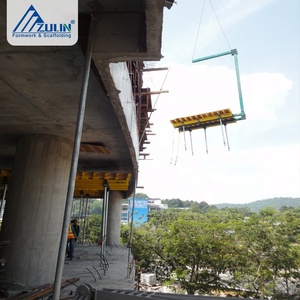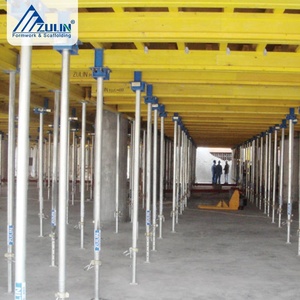
All categories
Featured selections
Trade Assurance
Buyer Central
Help Center
Get the app
Become a supplier

(1739 products available)














































Formwork timber for sale comes in different types to meet the needs of various construction projects. Here are some of the most common types:
Structural Formwork Timber
This formwork timber is engineered specifically for use in structural applications, such as formwork to cast concrete walls, beams, and slabs. It is designed to withstand high loads and pressures. Therefore, it is usually made of strong and durable materials like engineered wood, glulam beams, or solid sawn timber. Structural formwork timber is also treated with preservatives to enhance its longevity and resistance to moisture. Its dimensions vary depending on the structural requirements of the construction project.
Non-Structural Formwork Timber
This formwork timber is used for non-load-bearing applications in concrete formwork. It is lightweight and cost-effective, making it suitable for temporary applications. Non-structural formwork timber includes products like plywood, particleboard, and oriented strand board (OSB). It is also designed to provide a smooth concrete finish and is easy to handle and assemble.
Reinforced Formwork Timber
This timber is specially reinforced using steel or other high-strength materials to increase its load-bearing capacity and durability. It is used in applications where high pressure or load is expected, such as in the construction of large-scale concrete structures like dams, bridges, and high-rise buildings. The reinforcement can be in the form of steel rods, plates, or channels embedded into the timber.
Timber Plywood Formwork
Timber plywood formwork is a popular choice for concrete formwork. It consists of an engineered wood product made from layers of wood veneers glued together. The plywood is then treated with a waterproof coating to enhance its strength, durability, and resistance to moisture. This formwork timber is valued for its lightweight, high strength-to-weight ratio, and ability to provide a smooth concrete finish. It is also easy to work with and can be reused multiple times, depending on the quality of the plywood and the number of pours.
Structural Support:
Formwork timber creates molds that support the structure during construction. It holds the concrete shape until the concrete cures and hardens into the desired shape.
Load-Bearing Capacity:
Formwork timbers have high compressive strength and load-bearing capacity. Allowing them to support the weight of wet concrete, water, and other construction materials without sagging or collapsing.
Moisture Resistance:
Formwork timber is usually treated with chemicals to allow it to withstand moisture and water. This formwork timber feature prevents warping, rotting, and other forms of structural damage.
Durability:
Formwork timber is tough and durable. This ensures it can be used multiple times in different construction projects. This makes formwork timber a cost-effective option for construction companies.
Easy to Work With:
Formwork timber is easy to cut, shape, and assemble. This allows for the creation of custom forms for complex concrete structures. This feature gives architects and engineers the flexibility to design various structural shapes and sizes.
Timber Type:
Softwoods like pine and spruce are popular for formwork because they are lightweight and cost-effective. However, hardwoods like rubberwood are also used due to their durability. The choice of timber affects the formwork's performance, cost, and reusability.
Surface Finish:
Formwork timber can be smooth or textured. Smooth surfaces create finished concrete surfaces that require minimal finishing, while textured surfaces improve concrete bonding. However, they require more finishing.
Height Adjustment:
Formwork timber can be adjusted to different heights. This makes them suitable for various construction projects, including high-rise buildings and residential homes.
Eco-Friendly:
Formwork timber is made from wood, a renewable resource. Using formwork timber promotes sustainable construction practices and reduces the ecological footprint of construction projects.
Formwork timber for sale serves a variety of scenarios in the construction industry. Here are some common usage scenarios:
Concrete Pouring
Formwork is used to shape and support concrete during the pouring process. Timber formwork is assembled on-site to create molds for foundations, columns, beams, slabs, and walls. The formwork holds the liquid concrete in place until it cures and hardens into the desired shape.
Architectural Concrete Elements
Timber formwork is crafted to create intricate molds for decorative architectural features in concrete structures. This includes textured or patterned walls, arches, and vaults. The formwork captures the details required in the finished concrete.
Curved Surfaces
Timber formwork is flexible and can be shaped to create molds for curved surfaces. This is ideal for bridges, domes, and other structures with non-linear forms.
High-Rise Construction
Timber formwork is used for vertical elements in high-rise buildings. It is possible to use it to construct skyscrapers quickly and safely. The formwork can be stripped and reused for multiple floors, increasing efficiency.
Infrastructure Projects
Timber formwork is utilized in infrastructure projects such as dams, parking garages, and retaining walls. It creates the required concrete shapes and sizes in these large-scale structures.
Residential Construction
Formwork timber is used to cast concrete foundations, crawl spaces, and basements in residential buildings. It provides the necessary support and shape for these essential structural elements.
Bridge Construction
Timber formwork is employed to create concrete girders, abutments, and piers in bridge construction. It allows precise shaping and alignment of critical load-bearing elements.
Retaining Walls
Formwork timber is used to construct concrete retaining walls that hold back soil and water. It ensures the walls are formed and cured uniformly.
Column and Beam Formation
Timber formwork creates columns and beams of different sizes and shapes, including square, rectangular, and circular profiles.
Prefab and Modular Construction
In prefabricated and modular construction, timber formwork is used to cast concrete components such as walls, floors, and roofs that are assembled on-site.
When buying formwork timber, it is important to consider some factors to ensure the timber meets construction requirements. Here are some tips for choosing formwork timber for sale.
Q1: Is it possible to reuse formwork timber?
A1: Yes, it is possible to reuse formwork timber. In fact, formwork timber for sale is often designed for multiple uses. However, to ensure the formwork timber remains suitable for re-use, it should be well maintained and stored appropriately to prevent damage.
Q2: What should be done to formwork timber after use?
A2: After using formwork timber, it should be cleaned to remove any concrete residue. The timber should be inspected for any damages or cracks. It should also be treated and stored properly to prevent moisture and UV damage.
Q3: What are the common types of formwork timbers?
A3: The common types include Spruce, Pine, and Douglas Fir. Other types include Birch, Poplar, and Rubberwood.
Q4: What are the characteristics of good formwork timber?
A4: Good formwork timber should be straight, durable, and flexible. It should also be waterproof, and oil resistant, have a high bending strength, and be easily repairable and reusable.